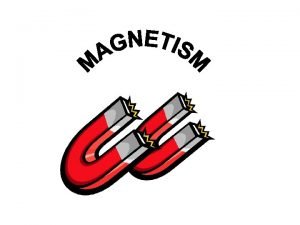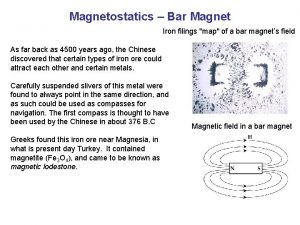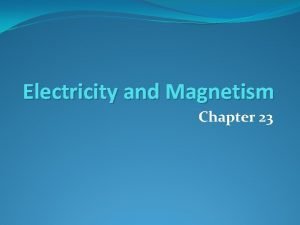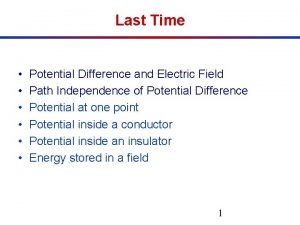Name Date CP The Oersted Experiment Hypothesis What



- Slides: 3

Name: ____________ Date: _____ CP: ____ The Oersted Experiment Hypothesis What is the relationship between electricity and magnetism? Data Collection 1. Create a series circuit with one bulb and two batteries. Place the compass next to the wire. Is the compass affected by the wire? What must be present for the compass to be affect by the wire? Disassemble your circuit. 2. Wrap the wire around the nail 10 times. Use tape to connect the ends of the wire to each end of the battery. How many paper clips can you pick up? 3. Place the compass next to the electromagnet. Was the compass affected by the electromagnet? What must be present for the compass and the paper clips to be affected. 4. Wrap the wire around the nail 20 times. How many paper clips can you pick up? 5. Now wrap the wire around the nail as many times as possible. How many paper clips can you pick up? 6. Place the compass next to the electromagnet again. Does the electromagnet you created in #4 affect the compass more or less than the electromagnet with only 10 coils? What has increased or decreased to cause this change? 7. Try connecting two batteries together. How does this affect the electromagnet? What increased to cause this change? 8. Draw the electromagnet you created and show the magnetic field around it. 9. Explain how an electromagnet is different from a permanent magnet. 10. Explain the relationship between electricity and magnetism. Conclusion 1. List three things you learned from this lab. 2. Name three uses for electromagnets. 3. Reflect on your original answer to the hypothesis. Think about what you learned in this lab and any changes you could make to your hypothesis. Answer the hypothesis again making any necessary adjustments to you answer? 4. Use REGS to explain how an electromagnet works.

Electricity and Magnetism Introduction Many similarities exist between electric and magnetic phenomena. A magnet has two opposite poles, referred to as north and south. Opposite magnetic poles attract each other, and similar magnetic poles repel each other, exactly as happens with electric charges. The force with which magnetic poles attract or repel each other depends on the strength of the poles and the distance between them. This relationship is similar to the Coulomb’s inverse square law for electric charges. See also Magnetism. The similarities between electric and magnetic phenomena indicate that electricity and magnetism are related. Electricity produces magnetic effects and magnetism produces electric effects. The relationship between electricity and magnetism is called electromagnetism. The study of this relationship is called Quantum Electrodynamics. Magnetic Effects of Electricity It has been noted that an electric field exists around any electric charge. If electric charges are moving, they constitute an electric current. The magnetic effect of electricity is demonstrated by the fact that a magnetic field exists around any electric current. The field can be detected when a magnet is brought close to the current-carrying conductor. The magnetic field around an electric current can be thought of as lines of magnetic force that form closed circular loops around the wire that carries the current. The direction of the magnetic field can be determined by a convenient rule called the right-hand rule. To apply this rule, the thumb of the right hand is pointed in the direction in which the current is flowing and the fingers are curled around the wire. The direction of the fingers then indicates the direction of the lines of magnetic force. (The right-hand rule assumes that current flows from positive to negative. ) Motor Effect As already stated, a magnetic field exists around a wire carrying an electric current, and a magnetic field exists between the two poles of a magnet. If the wire is placed between the poles, the magnetic fields interact to produce a force that tends to push the wire out of the field. This phenomenon, known as the motor effect, is used in electric motors. See also Electric Motors and Generators. Solenoids If a wire is bent into many continuous loops to form a long spiral coil, then the magnetic lines of force tend to go through the center of the coil from one end to the other rather than around the individual loops of wire. Such a coil, called a solenoid, behaves in the same way as a magnet and is the basis for all electromagnets. The end from which the lines exit is the north pole and the end into which the lines reenter is the south pole. The polarity of the coil can be determined by applying the left-hand coil rule. If the left hand grasps the coil in such a way that the fingers curl around in the direction of the electron current, then the thumb points in the direction of the north pole. Electric Effects of Magnetism If a wire is moved through a magnetic field in such a way that it cuts the magnetic lines of force, a voltage is created across the wire. An electric current will flow through the wire if the two ends of the wire are connected by a conductor to form a circuit. This current is called an induced current, and the induction of a current in this manner is called electromagnetic induction. It does not matter whether the wire moves or the magnetic field moves, provided that the wire cuts through lines of force. If a magnet is moved near a stationary wire, the lines of magnetic force are cut by the wire and an electric current is induced in the wire. Like any electric current, an induced current generates a magnetic field around it. Lenz’s law expresses an important fact concerning this magnetic field: The motion of an induced current is always in such a direction that its magnetic field opposes the magnetic field that is causing the current. Source: Kids Research Express: http: //kidsresearchexpress-2. blogspot. com/2008/09/electricity-and-magnetism. html

Teacher Notes Every time an electric charge moves, a magnetic field is created, and every time a magnetic field is varied an electric field is created. Electricity and Magnetism Electricity and magnetism are interrelated. When a magnet moves past a wire, an electric current is created in that wire. When an electric current runs through a wire, a small magnetic field is created around the wire. We can create a simple electromagnet by causing an electric current to flow through a coil of wire. An electromagnet is a temporary magnet, which means that when we shut off the electricity, the magnet stops working.





